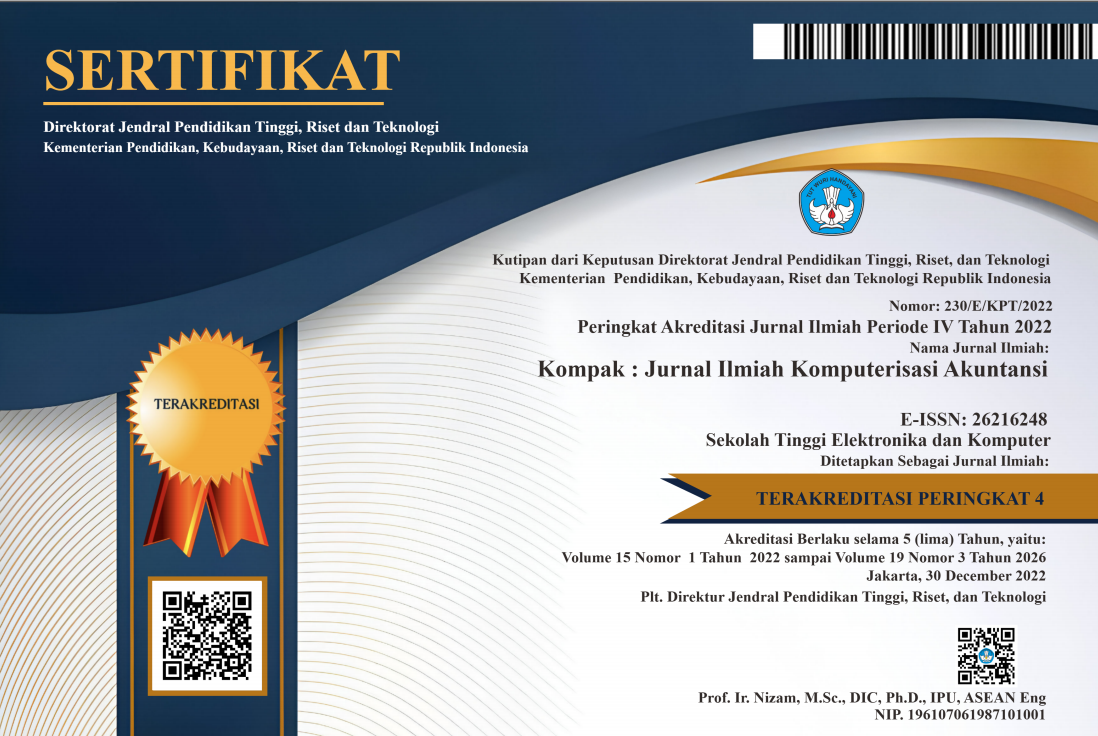Penggunaan Mobile Payment Pada Mahasiswa Telkom University
DOI:
https://doi.org/10.51903/kompak.v16i2.1261Keywords:
digital payment, ease of use, mobile payment, perceived usefulness, risk, trustAbstract
This research aimed to analyze the effect of perceived usefulness, perceived ease of use, perceived trust, and perceived risk on the use of mobile payments by Telkom University students. The use of mobile payments is a method that can be used as an alternative to cash, checks, credit cards, and debit cards and can create new opportunities for payment methods. The population in this study was all Telkom University students. The sampling technique used is the probability sampling technique. The sample used was 282 respondents. Data was obtained through the distribution of questionnaires through Google Forms. The analytical method uses multiple linear regression analysis using SPSS version 26 software. The results show that perceived usefulness, perceived ease of use, perceived trust, and perceived risk have a positive effect on the use of mobile payments. The results of this study are expected to provide an overview for digital payment service providers to improve service quality in using mobile payments so that they can maintain user consistency, increase security so the user trust does not decrease, and pay attention to risks that may occurarticle.
References
[2] Bank Indonesia, “Apa Itu Elektronifikasi,” www.bi.go.id, 2020.
[3] A. R. Rahim Amihsa, E. Saferian, and S. Syahrir, “Faktor-Faktor Yang Mempengaruhi Penggunaan Mobile Payment Di Indonesia,” 2020.
[4] I Gusti Bagus Irvan Prasetya and I Gusti Ayu Purnamawati, “Pengaruh Nilai Harga, Motivasi Hedonis, Kebiasaan dan Daya Tarik Promo terhadap Minat Menggunakan Mobile Payment OVO,” Jurnal Akuntansi Profesi, vol. Vol. 11, Jun. 2020, Accessed: Oct. 16, 2022. [Online]. Available: https://www.jurnalintelektiva.com/index.php/jurnal/article/view/306/212
[5] D. Irawan and M. W. Affan, “Pengaruh Privasi Dan Keamanan Terhadap Niat Menggunakan Payment Fintech,” Jurnal Kajian Akuntansi, vol. 4 No.1, 2020, [Online]. Available: http://jurnal.unswagati.ac.id/index.php/jka
[6] F. D. Davis, “Perceived usefulness, perceived ease of use, and user acceptance of information technology,” MIS Q, vol. 13, no. 3, pp. 319–339, 1989, doi: 10.2307/249008.
[7] V. Venkatesh and F. D. Davis, “Theoretical extension of the Technology Acceptance Model: Four longitudinal field studies,” Manage Sci, vol. 46, no. 2, pp. 186–204, 2000, doi: 10.1287/mnsc.46.2.186.11926.
[8] M. N. Huddin and M. R. Masitoh, “Persepsi Kegunaan dan kemudahan menggunakan terhadap Niat Menggunakan Mobile Payment dimasa Pandemi Covid-19,” JURNAL AL-QARDH, vol. 6, no. 1, pp. 1–16, Aug. 2021, doi: 10.23971/jaq.v6i1.2699.
[9] L. Namira, “Faktor-Faktor Yang Mempengaruhi Niat UMKM di Kota Padang Menggunakan e-Payment sebagai Metode Pembayaran,” Owner, vol. 6, no. 1, pp. 212–224, Jan. 2022, doi: 10.33395/owner.v6i1.553.
[10] S. L. Jarvenpaa, N. Tractinsky, and M. Vitale, “Article in Information Technology and Management,” Information Technology and Management, vol. 1, pp. 45–71, 2000, doi: 10.1023/A:1019104520776.
[11] D. Cynthia Kumala, J. Wilson Pranata, S. Thio, P. Manajemen Perhotelan, and F. Bisnis dan Ekonomi Universitas Kristen Petra, “Pengaruh Perceived Usefulness, Perceived Ease Of Use, Trust, Dan Security Terhadap Minat Penggunaan Gopay Pada Generasi X Di Surabaya,” Jurnal Manajemen Perhotelan, vol. 6, no. 1, pp. 19–29, 2020, doi: 10.9744/jmhot.6.1.19-29.
[12] I. Im, Y. Kim, and H. J. Han, “The effects of perceived risk and technology type on users’ acceptance of technologies,” Information and Management, vol. 45, no. 1, pp. 1–9, Jan. 2008, doi: 10.1016/j.im.2007.03.005.
[13] Lennart Sjoberg, Bjorg-Elin Moen, and Torbjorn Rundmo, Explaining risk perception. An evaluation of the psychometric paradigm in risk perception research. www.yumpu.com, 2014.
[14] Z. Janneth and D. Sari, “Pengaruh Trust, Perceived Risk, Perceived Usefulness Dan Perceived Ease Of Use Terhadap Intention To Use Pada Layanan Gopay Di Kota Bandung The Effect Of Trust, Perceived Risk, Perceived Usefullness And Perceived Ease Of Use On Intentions To Use Gopay Services In Bandung City.”
[15] A. Daragmeh, C. Lentner, and J. Sági, “FinTech payments in the era of COVID-19: Factors influencing behavioral intentions of ‘Generation X’ in Hungary to use mobile payment,” J Behav Exp Finance, vol. 32, Dec. 2021, doi: 10.1016/j.jbef.2021.100574.
[16] J. Li, J. Wang, S. Wangh, and Y. Zhou, “Mobile Payment with Alipay: An Application of Extended Technology Acceptance Model,” IEEE Access, vol. 7, pp. 50380–50387, 2019, doi: 10.1109/ACCESS.2019.2902905.
[17] C. Sudyasjayanti and A. F. Gadi, “Pengaruh Perceived Ease Of Use, Perceived Usefulness, dan Trust terhadap Intention To Use Mobile Payment pada Pria dan Wanita,” Jurnal Mirai Management, vol. 7, no. 2, pp. 222–231, 2022, doi: 10.37531/mirai.v7i2.2014.
[18] O. Riandani, M. Fakhri, and M. Pradana, “The Relationship between Digital Wallet Adoption and Usage to Financial Inclusion with Trust as A Mediator.”














.png)



